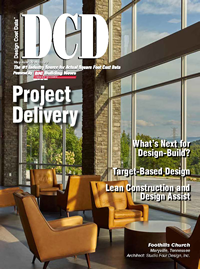Learning From the Past While Looking to the Future
This article was written by Michael Boren, CTO at Beck Technology, and published in the May/June 2019 edition of DCD Magazine.

When the telephone first became available to the public, it was difficult to get people to adopt this new way of communication. Many people were suspicious of the telephone and even believed that it could make a person go deaf or that others could eavesdrop on your private conversations. Telegraph companies helped perpetuate these rumors because they were afraid that telephones would soon make them irrelevant. Ultimately, it would take innovative, forward-thinking people to take a chance on a rapidly evolving technology in order for telephones to start becoming a more widely accepted avenue of communication. Before long, other consumers and businesses began following in the wake of these trailblazers, as they witnessed the efficiencies and benefits of this new tool.
Whether you’re talking about telephones or construction, the success of a new product or software in any industry always depends on the same kinds of people who took a chance on the telephone: people who are excited about change, who look back on the past for wisdom but also look forward to the future for innovation, who are willing to try different approaches to challenging problems, even if that might not be the way they would usually do it. Today, the world of construction – and especially preconstruction - is at a similar crossroads. There are more tools and systems available than ever before, all meant to streamline workflows and reduce inefficiencies. But it can be difficult to leave behind what you know, and for good reason. Adopting a new estimating software often means months of training to understand the software’s ins and outs, overhauling existing processes to better reflect where the company is at, and setting aside time to develop a comprehensive implementation plan with the software vendor. At the end of the day, a lot of companies may not even have the bandwidth to take on this kind of project.
That’s why trailblazers are so critical to the industry – in order to make the burdens of change a little lighter, there needs to be companies who are willing to take the lead and try new approaches to old problems so that their peers can learn from their experiences and have a reference point when they’re ready to start expanding their toolkit. Revolutionizing the construction industry requires companies to question the status quo, look for areas of improvement, and then put those ideas into action. Gilbane Building Company, whose brand is based on Building More Than Buildings®, is doing just that.
Since their beginnings in 1873, Gilbane has always been a company led by people who learn from the past while innovating for the future. Whether it’s coming back in full force after a devastating fire that torched their headquarters in 1897 or driving the charge to expand into markets far beyond the United States, Gilbane has never settled for “good enough.” So as construction technology began to emerge in the marketplace, Gilbane was an early adopter as they brought these technological developments into their workflows.
One area in which their trailblazing efforts especially shone was their preconstruction department. Preconstruction often has a reputation for being one of the last to integrate new technology into their workflows; but at Gilbane, this wasn’t the case. In keeping with their desire to welcome new ideas and processes in every aspect of their company, they decided to introduce a new estimating system into their pre-construction department. Gilbane made this decision not only because they felt it would help them discover innovative solutions to preconstruction challenges, but also because they felt that it would create a ripple effect of even more efficient workflows and improved communication across all departments.
More exact data
Gilbane is a very large general contractor global leader in construction and facilities-related services, and as a result, they have a plethora of data to reference in their estimates. Pulling data from multiple projects also means pulling in the collective knowledge that went into those numbers. Adopting a new estimating system enables them to use comparison data that will be integrated into the new platform. This translates into greater clarity not only for the client, but also for the team as well.
Streamline pre-construction efforts
Everyone knows that it’s not always easy to streamline preconstruction workflows - many estimators use two or three different tools at a time on a daily basis. Transitioning into using just one tool across the whole company brought a number of benefits to Gilbane.
First, being able to consolidate data into one central database and use as a foundation to inform future estimates improved efficiencies. Additionally, using one estimating platform for the entire company means that everyone will speak the same estimating language at Gilbane, but still have enough customization to meet client demands. Sharing a common language also makes collaboration between different offices much easier, which is incredibly important when it comes to problem-solving, offices who have had experiences with particularly difficult types of projects can share their expertise and advice with the offices who haven’t. Additionally, since the data is more exact and there is consistency in every estimate, this translates into better transparency for clients.
Consistency in every office
The adoption of this technology also allowed Gilbane to produce creative solutions to problems by providing increased consistency. When team members speak the same estimating language, it leads to a rapid increase of industry knowledge, sharing of information, and building upon a familiar platform. All of these factors translate into greater resources for all offices, as well as faster turnaround on overcoming difficult challenges. This is the framework for a reliable company who is driving change to deliver projects more efficiently for their clients.
More value to clients
Gilbane has always aimed to give their clients clarity, transparency, and consistency. By embracing new technology and choosing to onboard a new estimating system that supports their goals more effectively, it will give them a springboard to win over new clients and strengthen their current relationships.
It’s never easy to be a trailblazer. Even though technology usually means faster workflows and fewer errors, it still takes time, money and effort to onboard a new system and learn all of the processes and features that go with it. But without trailblazers leading the way, it’s all too easy for things to stagnate, on both the side of the general contractors and the side of software vendors.
As more general contractors follow Gilbane’s example and begin to implement new technology into their day-to-day workflows, it’s important to remember that a revolution requires more than one company to ask hard questions and decide if more innovative processes are a better fit for their workflows. Those that do will stand out in an industry that is primed for a technological revolution that will deliver powerful results.

-1.png?width=112&height=112&name=image%20(4)-1.png)














